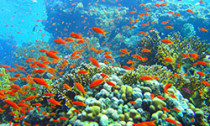
Earlier this fall, Abbott announced plans to develop a massive new coal exporting terminal on the northeast coast of Australia. In order to accommodate the large ocean-going freighters, some 3 million cubic meters of seabed will have to be dredged — and plans call for it to be dumped on the nearby Great Barrier Reef, according to an article in The Guardian.
Coral reefs are not just picturesque inanimate formations on the sea floor. They are living structures, and the Great Barrier Reef is the largest living structure in the world. Further, it supports an intricate and extensive ecosystem.
According to Australia’s Great Barrier Reef Marine Park Authority, there are 600 different types pf corals, 150 species pf jellyfish, 3,000 varieties of mollusks, 500 species of worms, 1,625 types of fish, 133 varieties of sharps and rays, and 30 species of whales and dolphins that live there. It also supports the tourism, fishing, and other recreation industries.
The reef is 2,300 km long and 60 to 25 km wide, so massive it is visible from space. It is considered so valuable that it was named a Unesco World Heritage Area in 1981.
Not surprisingly, Abbott’s Environmental Minister, Greg Hunt, issued a statement that strict conditions would be placed on the dredging to minimize environmental damage. It’s hard to imagine just what kind of conditions can be imposed on a project that is inherently destructive from start to finish.
The area to be dredged is home to several rare species of turtles — the dredging and increased shipping activity will disrupt and destroy their habitat, and there is concern that they will not be able to adapt to the new conditions. Dumping such a huge amount of silt on the fragile coral reefs will severely damage, perhaps destroy them. There is also concern about how far the silt might spread, increasing the extent of the damage.
All this — the threat to the marine life of the reef and to the humans who depend on them — is all for the sake of increasing Australia’s coal exports. Already the country’s second-largest export commodity, according to the Australian Coal Association, the volume would be boosted by 600%, according to the Guardian.
Most of Australia’s coal goes to Japan, China, and Korea — countries that are already suffering from severe pollution problems linked to coal-burning facilities. Not that Abbott and his Liberal National Party care.
“We will take direct action to reduce carbon emissions inside Australia, not overseas,” reads a statement on the Liberal National Party website. The statement goes on to say they will hire 15,000 greens to clean up polluted sites around Australia. How very sporting of them.
It’s appalling that in this day and age the leader of one of world’s great nations can display such a callous disregard for one of his country’s natural treasures, all in the name of boosting the profits of one special interest.
A small ray of hope is that a decision on the plan by the Marine Park Authority has been delayed by a month, to January 31, 2014, according to an Australian news website. It had been expected that they would announce their decision Friday. Hopefully, the international community can find some way to prevent the Abbott government from going forward with this flawed and dangerous plan.











Social Profiles